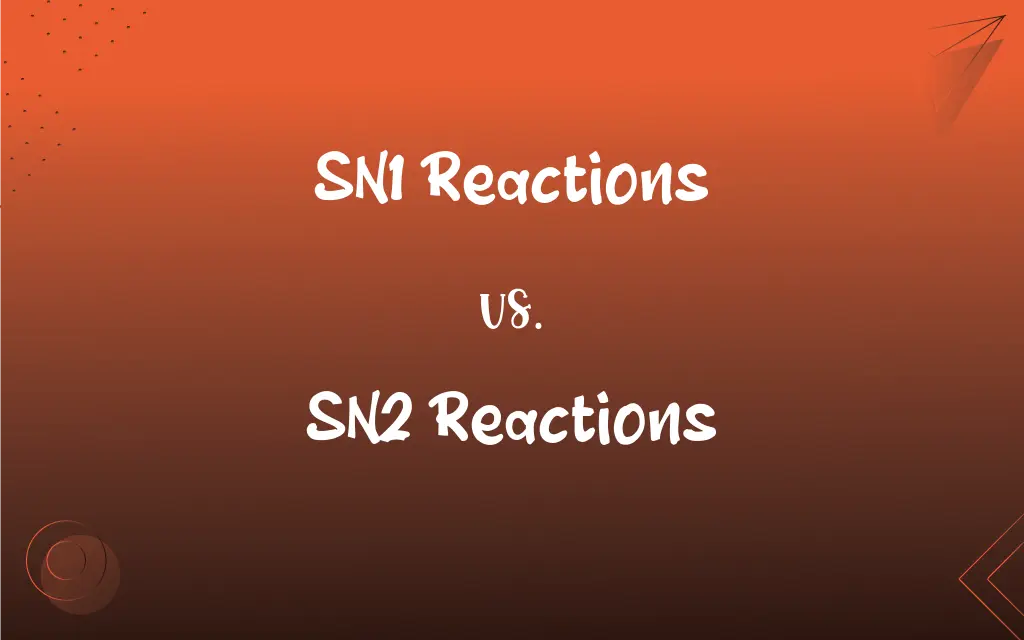SN1 Reactions vs. SN2 Reactions: What's the Difference?
Edited by Janet White || By Harlon Moss || Updated on October 16, 2023
SN1 reactions are unimolecular, involving a two-step process; SN2 are bimolecular with a one-step mechanism.

Key Differences
SN1 reactions involve a two-step mechanism, where the departure of a leaving group occurs, forming a carbocation intermediate. SN2 reactions, however, proceed via a one-step mechanism where the nucleophile performs a concerted attack.
SN1 reactions show first-order kinetics, meaning the reaction rate depends solely on the concentration of the substrate. In contrast, SN2 reactions exhibit second-order kinetics, with the rate depending on both the substrate and nucleophile.
Stereochemistry in SN1 reactions leads to racemization, due to the planar nature of the carbocation intermediate. Conversely, SN2 reactions result in a stereospecific inverted configuration at the reaction center, owing to the backside attack mechanism.
SN1 reactions prefer polar protic solvents which stabilize the transition state. SN2 reactions, though, are favored by polar aprotic solvents that accelerate the nucleophile's reactivity.
The reactivity in SN1 reactions is affected by the carbocation stability; tertiary substrates are most reactive. For SN2 reactions, methyl and primary substrates are ideal due to less steric hindrance.
ADVERTISEMENT
Comparison Chart
Mechanism
Two-step with intermediate
One-step concerted process
Rate Determination
First-order kinetics
Second-order kinetics
Stereochemistry
Leads to racemization
Inversion of configuration
Solvent
Prefer polar protic solvents
Favor polar aprotic solvents
Substrate
Tertiary substrates most reactive
Methyl/primary substrates preferred
ADVERTISEMENT
SN1 Reactions and SN2 Reactions Definitions
SN1 Reactions
SN1 reactions are favored in tertiary carbons due to the stability of the resultant carbocation.
The tert-butyl halide readily underwent the SN1 reaction, showcasing the preference for tertiary substrates.
SN2 Reactions
SN2 reactions result in an inversion of stereochemistry, known as the Walden inversion.
The product of our SN2 reaction had an inverted configuration compared to our original chiral substrate.
SN1 Reactions
SN1 reactions occur with racemization in chiral centers due to the non-specific reattachment of the nucleophile.
The SN1 reaction led to a racemic mixture, indicative of its planar intermediate stage.
SN2 Reactions
SN2 reactions are facilitated by polar aprotic solvents due to the solvation of the nucleophile and substrate.
Acetone, a polar aprotic solvent, was ideal for our SN2 reaction, increasing the nucleophile's reactivity.
SN1 Reactions
SN1 reactions are unimolecular nucleophilic substitutions involving a two-step mechanism.
In the lab, we observed the SN1 reaction of tert-butyl chloride with water, forming a carbocation intermediate.
SN2 Reactions
SN2 reactions are bimolecular nucleophilic substitutions characterized by a one-step mechanism.
The SN2 reaction of methyl bromide with hydroxide was rapid and occurred via a backside attack.
SN1 Reactions
SN1 reactions prefer polar protic solvents that stabilize the ionization step.
The SN1 reaction progressed rapidly in our chosen polar protic solvent, ethanol.
SN2 Reactions
SN2 reactions prefer primary or methyl substrates due to lower steric hindrance.
The primary chloride reacted swiftly in the SN2 reaction, while the tertiary chloride showed no reaction.
SN1 Reactions
SN1 reactions involve a rate-determining step, the loss of the leaving group to form a planar carbocation.
The slow formation of the carbocation in our SN1 reaction determined the overall rate of the process.
SN2 Reactions
SN2 reactions proceed with a concerted mechanism, where the bond-forming and bond-breaking occur simultaneously.
In our experiment, the SN2 reaction showed a transition state where both bonds were partially formed and broken.
FAQs
What kinetics do SN2 reactions follow?
SN2 reactions have second-order kinetics, depending on both nucleophile and substrate.
How do SN2 reactions proceed?
SN2 reactions occur in a single concerted step with a transition state.
Are SN1 reactions first or second order?
SN1 reactions follow first-order kinetics, depending on the substrate concentration.
What defines SN1 reactions?
SN1 reactions are characterized by a two-step mechanism with a carbocation intermediate.
What happens to stereochemistry in SN1 reactions?
SN1 reactions lead to racemization due to a planar carbocation intermediate.
Which substrates are suitable for SN1 reactions?
Tertiary substrates are most suitable for SN1 reactions due to carbocation stability.
How does stereochemistry change in SN2 reactions?
SN2 reactions cause an inversion of configuration due to a backside attack.
What solvents are preferred in SN1 reactions?
Polar protic solvents are preferred for SN1 reactions.
What substrates are ideal for SN2 reactions?
Primary and methyl substrates are ideal for SN2 reactions due to less steric hindrance.
Are tertiary carbons suitable for SN2 reactions?
Tertiary carbons are usually not suitable for SN2 reactions due to significant steric hindrance.
What is the role of the leaving group in SN1 reactions?
In SN1 reactions, a good leaving group is crucial as it departs in the rate-determining step.
Which solvents enhance SN2 reactions?
Polar aprotic solvents are favorable for SN2 reactions.
How does temperature affect SN1 reactions?
Higher temperatures favor SN1 reactions as they help overcome the energy barrier for carbocation formation.
Do SN2 reactions depend on temperature?
While SN2 reactions are generally faster at higher temperatures, they're not as temperature-dependent as SN1.
How important is the leaving group in SN2 reactions?
In SN2 reactions, the leaving group's ability to depart easily is key to a successful reaction.
Can SN1 reactions occur with primary carbons?
SN1 reactions rarely occur with primary carbons due to the instability of primary carbocations.
Do SN1 reactions require a strong nucleophile?
SN1 reactions do not require a strong nucleophile since the carbocation intermediate is highly electrophilic.
Are strong nucleophiles necessary for SN2 reactions?
Strong nucleophiles are favored in SN2 reactions to promote the bimolecular attack on the substrate.
Why are SN1 reactions called unimolecular?
SN1 reactions are unimolecular because the rate-determining step involves only the substrate.
Why are SN2 reactions termed bimolecular?
SN2 reactions are bimolecular because the rate involves both the substrate and the nucleophile.
About Author
Written by
Harlon MossHarlon is a seasoned quality moderator and accomplished content writer for Difference Wiki. An alumnus of the prestigious University of California, he earned his degree in Computer Science. Leveraging his academic background, Harlon brings a meticulous and informed perspective to his work, ensuring content accuracy and excellence.
Edited by
Janet WhiteJanet White has been an esteemed writer and blogger for Difference Wiki. Holding a Master's degree in Science and Medical Journalism from the prestigious Boston University, she has consistently demonstrated her expertise and passion for her field. When she's not immersed in her work, Janet relishes her time exercising, delving into a good book, and cherishing moments with friends and family.































































